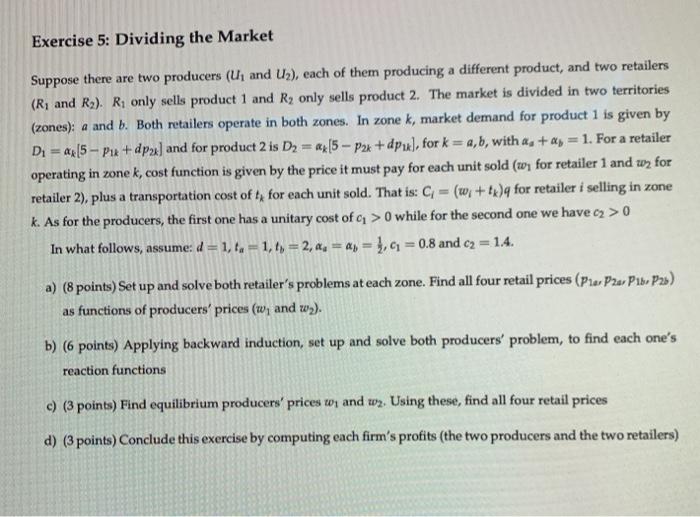Exercise 5: Dividing the Market Suppose there are two producers (U and Uz), each of them producing a different product, and two retailers (R, and R2). R; only sells product 1 and R, only sells product 2. The market is divided in two territories (zones): a and b. Both retailers operate in both zones. In zone k, market demand for product 1 is given by D = x/5 - Pu+dpx) and for product 2 is D2 = ax(5 - Pxx+dpu), for k= a, b, with & + ay = 1. For a retailer operating in zone k, cost function is given by the price it must pay for each unit sold (w for retailer 1 and wy for retailer 2), plus a transportation cost of t, for each unit sold. That is: C = (w/ + 1x) for retailer i selling in zone k. As for the producers, the first one has a unitary cost of c; > while for the second one we have 2 > 0 In what follows, assume: d=1,1,-1, 1) = 2, &. = 4) = 1,6 = 0.8 and c2 = 1.4. a) (8 points) Set up and solve both retailer's problems at each zone. Find all four retail prices (Pla P2, P1, P2) as functions of producers' prices (w, and w). b) (6 points) Applying backward induction, set up and solve both producers' problem, to find each one's reaction functions c) (3 points) Find equilibrium producers' prices w and w2. Using these, find all four retail prices d) (3 points) Conclude this exercise by computing each firm's profits (the two producers and the two retailers) Exercise 5: Dividing the Market Suppose there are two producers (U and Uz), each of them producing a different product, and two retailers (R, and R2). R; only sells product 1 and R, only sells product 2. The market is divided in two territories (zones): a and b. Both retailers operate in both zones. In zone k, market demand for product 1 is given by D = x/5 - Pu+dpx) and for product 2 is D2 = ax(5 - Pxx+dpu), for k= a, b, with & + ay = 1. For a retailer operating in zone k, cost function is given by the price it must pay for each unit sold (w for retailer 1 and wy for retailer 2), plus a transportation cost of t, for each unit sold. That is: C = (w/ + 1x) for retailer i selling in zone k. As for the producers, the first one has a unitary cost of c; > while for the second one we have 2 > 0 In what follows, assume: d=1,1,-1, 1) = 2, &. = 4) = 1,6 = 0.8 and c2 = 1.4. a) (8 points) Set up and solve both retailer's problems at each zone. Find all four retail prices (Pla P2, P1, P2) as functions of producers' prices (w, and w). b) (6 points) Applying backward induction, set up and solve both producers' problem, to find each one's reaction functions c) (3 points) Find equilibrium producers' prices w and w2. Using these, find all four retail prices d) (3 points) Conclude this exercise by computing each firm's profits (the two producers and the two retailers)







